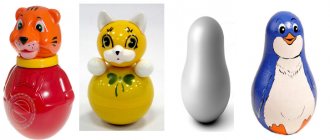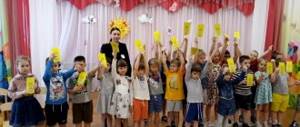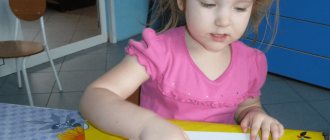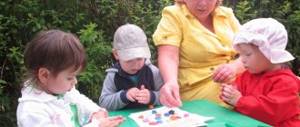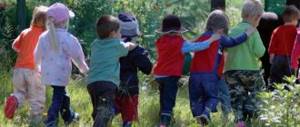The meaning and purposes of theatricalization
Theatricalization is a type of play activity that is used to reveal the creative potential of children using dramatization techniques, that is, role-playing according to a pre-agreed scenario, as well as various exercises aimed at mastering acting skills.
Theatrical performance is an indispensable element of matinees
Theatricalization is valuable because it includes work on the development of monologue and dialogic speech, and this increases the communication skills of children. Theatricalization involves:
- working on the expressiveness of characters’ lines;
- expansion of the child’s active and passive vocabulary;
- improving the pronunciation of speech sounds, as well as intonation structure.
In addition, the goals of theatricalization are:
- comprehensive acquaintance with various manifestations of reality (professions, animals, natural phenomena);
- stimulation of the child’s creative potential (through songs and music, dancing, games);
- development of the child’s emotional sphere due to deep experiences during the game;
- formation of social behavior skills;
- introducing preschoolers to reading;
- development of directing skills;
- embodiment in a creative impulse of the mood, character and process of character development of the character.
Theater is a magical world. He gives lessons in beauty, morality and ethics. And the richer they are, the more successful the development of the spiritual world of children is...
B. M. Teplov, Soviet psychologist
Video: presentation of types of theater for kindergarten (tabletop from knitted toys, on jars, on spoons, shadow theater)
Theater production "Bibabo Theater"
Theater "Bibabo"
Goal:
to develop children's creative speech activity.
Tasks
Educational:
practice lexical formulation of statements; intensify the use in speech of words used in fairy tales; practice grammatical formatting of statements and the use of direct speech; create conditions for the sensorimotor level of speech; develop articulatory motor skills; intonation expressiveness of speech; consolidate skills in programming narrative statements; practice collective composing of a creative statement.
Educational:
develop conscious speech activity when composing creative statements; speech and mental operations; auditory perception.
Educational:
develop the ability to work in a team: negotiate, distribute roles, act together, focus on a partner.
Preliminary work:
staging fairy tales at the Bibabo Theater; reading fairy tales; didactic games “Guess who’s talking” and “Guess who called.”
Equipment:
puppets of the Bibabo theater (for three subgroups of children); TV model; microphone; sundress and scarf for “Grandma Rasskazushka”; "magic chest"; audio recording of music from the TV show “Visiting a Fairy Tale”; screen.
* * *
Creating a speech-activating situation
The teacher plays the role of Grandma Rasskazushka.
An audio recording of music from the TV show “Visiting a Fairy Tale” is played. Grandma Rasskazushka sits at a model TV, next to her is a magic chest. Grandma Story.
Hello, my dear!
Today a fairy tale has come to visit you again. Last time we met, you told so many new interesting tales for my magic chest! Today new fairy-tale heroes want to meet you, maybe you will write new fairy tales about them? (Takes out puppets from the Bibabo theater from the magic chest: an old man, an old woman, a gray wolf, a fox, a bear, a prince, a princess.)
These are the heroes of future fairy tales. Now we will divide into three teams, each will compose their own fairy tale, and then show it in the TV show “Theater “Bibabo””. But we will now find out which team will get which heroes. Children are divided into three teams as desired. The dolls hide behind the screen. One child comes behind her, chooses any doll there and in the voice of this character says: “Welcome to the fairy tale!” The other children must guess who it is. The team that guesses correctly receives this fairy-tale character.
The teacher can show game actions for the first time. Development of internal programming activities
After the teams have received their fairy-tale characters, Grandma Rasskazushka asks the children to remember the sequence of composing the story without relying on the model. Then the rules are given that children must follow when working on a fairy tale: a fairy tale must be invented together; after composing it, distribute the roles, who will be which character, do not forget to choose a presenter who will speak the text of the fairy tale; rehearse a fairy tale. Creating conditions for the sensorimotor level of speech
Physical education lesson
“A fairy tale is calling us to visit...” A fairy tale is calling us to visit, Children walk in a circle.
Get into a round dance.
Right from the doorstep
A path awaits us. In the fairy tale, dark forests Hands rise up and stretch.
Grow into the sky.
Let's sit with friends. They sit on their heels.
On Buyan Island. Geese-swans are flying, using their hands to depict flapping
their wings.
They want to say hello.
Dry your feathers Do a finger exercise
And peck the grains. “The chicken is pecking the grains.”
The magic horse galloped, They perform the “Horse” exercise.
The hungry wolf growled. Pronounce the sound [r-r-r].
And three smart cats perform the “Accordion” exercise.
They play the harmonica. Activation of linguistic design of utterances
Children work in teams. The teacher assists subgroups in composing a fairy tale, distributing roles, reminds them of the need to come up with dialogues for characters, controls the interaction of children in subgroups, prevents conflicts and helps to come to an agreement.
After the fairy tales are invented and rehearsed, the children take turns acting them out in the Bibabo Theater. Fairy tales are analyzed by children according to the questions: Did you like the fairy tale? What did you like most? Was the fairy tale clear? Any part missing? Which characters in the fairy tale turned out to be more expressive and similar? (Individual praise should be given to those who portrayed the characters.) Was the fairy tale interesting? Isn't it similar to something already known? Is it possible to keep it in Grandma Rasskazushka's chest?
After all the fairy tales, Grandma Rasskazushka thanks for the new fairy tales and leaves.
Work in the theater corner
Activities related to theatrical performances in kindergarten are implemented by several types of play activities:
- Director's games. In them, the child only leads the doll, conveying the image of the character with intonation and some other techniques. The possibilities of pantomime here are also very limited, because the toy is almost static (puppets on canes, puppets).
- Dramatizations. The baby plays the role himself, without resorting to the mediation of dolls. The young actor is able to actively use intonation, facial expressions, movements and gestures to enter into the character of the hero.
- Dramatizations with bibabo, finger, floor or scarf puppets. The baby acts for the character, giving him his voice. The work is carried out from behind a screen or with a character in hand.
Working with floor dolls is very difficult, but exciting for children - you cannot use facial expressions
- Improvisation. Children act out themes, not plots. Such theatrical activity requires almost no preparatory work, but is the most complex type of game. Various theatrical props can be used for improvisation.
The theater corner, which has everything necessary for the relevant activity, allows you to create a comfortable environment in the group for the development of the creative abilities of students. Theatricalization is a special area of the educational program for preschool institutions, because it gives children the opportunity not only to explore the world around them, but also to learn to live in harmony with it. In addition, theatrical performances help children become more self-confident, which is also important for their personal growth - which means that a kindergarten cannot be without a theater corner.
Master class “The World of Glove Theater”
Arskaya Veronica
Master class “The World of Glove Theater”
Arskaya Veronika Viktorovna
Master class for educators “ do-it-yourself glove theater ”
Master class : “The world of glove theater ”
Goal: To interest and encourage educators to make glove theater , with their subsequent use in theatrical activities for preschool children.
Contribute to improving the professional skills of teachers through
Formation of ideas about the diversity of puppet theater , making a doll from scrap material.
Tasks. To provide practical knowledge and skills for making a simple glove theater .
Tasks:
• Arouse interest in theatrical and play activities.
• Introduce the technology of making a glove puppet , using waste material in the work.
• Increasing the professional level and exchange of experience of participants, broadening their horizons.
• Train workshop in specific skills for making toys for the puppet theater .
Develop creative initiative, imagination, imagination, manual skills;
Cultivate interest in theatrical activities , in the popularization of innovative ideas and author's discoveries.
Expected results of the master class :
— understanding by its participants of the essence of the work of a master teacher ;
— practical mastery of master class ’ skills in making toys for the puppet theater ;
— activation of cognitive activity of master class ;
— increasing the level of professional competence of master class participants in theatrical activities and increasing motivation to form their own interest in theatrical activities .
Dear Colleagues. The topic of our meeting today is “Do it yourself puppet theater ”
,task: making
theatrical characters from waste material.
For work we will need: fleece (of different colors, templates of fairy tale characters, a glue gun, accessories for design and decoration, and the desire to create).
Redraw the templates onto fleece, cut them out, then design the hero and glue them to the glove . gloves the size of a child’s palm, so that children can play comfortably and easily. They are bright, soft, so children adore them, easy to wash, and environmentally friendly. With their help you can show familiar fairy tales, such as “Teremok”
,
“Kolobok”
,
“The Wolf and the Fox”
and others, as well as nursery rhymes and poems.
Theatrical activities of preschool children. Bi ba bo theater
Marina Vladimirova
Theatrical activities of preschool children. Bi ba bo theater
Theatrical play in the life of a preschooler
Preschool children love fairy tales very much. While listening to a fairy tale, the child imagines himself in one role or another, mentally finds himself in “fairy-tale situations”
, discovering something intimate and exciting.
In the soul of every child lies a desire for free theatrical play , in which he reproduces familiar literary plots. This is what activates his thinking, trains memory and visual perception, develops imagination and fantasy, and improves speech. It is theatrical games that make it possible to solve many pedagogical problems. They are an inexhaustible source of development of feelings, experiences and emotional discoveries, a way of becoming familiar with spiritual wealth. The use of theatrical games in working with children helps them apply the acquired knowledge in practice, show creativity in various types of theatrical activities.
A little history
Puppet theater has existed for a very long time. Ancient peoples believed that different gods, evil and good spirits lived in heaven, on earth, underground, and in water. To pray to them, people made images of large and small dolls from stone, clay, bone and wood. They danced around such dolls, drove them in chariots, and made cunning devices for opening their eyes, nodding their heads, and baring their teeth in the dolls. Gradually, such spectacles began to look more and more like theatrical performances . For a thousand years, in all countries of the world, with the help of dolls, legends about gods, demons, devils, angels were played out, human vices were ridiculed: stupidity, greed, cowardice, cruelty.
Puppet theater is a type of theatrical performance in which puppets act, driven by actors-puppeteers, most often hidden from the audience.
The Bi-Ba-Bo Puppet Theater or the Petrushki
called
the theater , the puppets of which are put on three fingers of the hand - like a glove.
In Italy, these dolls used to be called burattini, now they are called pupatzza. In Russia, this puppet character was named Petrushka. Parsley is the favorite character among the buffoons who gave performances for the audience. He is a daring daredevil and a bully who maintained a sense of humor and optimism in any situation. He always deceived the rich and government officials. In such a theatrical performance, two heroes acted simultaneously (according to the number of hands of the puppeteer)
: Parsley and the doctor
(policeman)
.
The plots were the most common, for example, Petrushka gets married or buys a horse. He always participated in conflict situations, and his reprisals were quite harsh, but the public never condemned him for this. At the end of the performance, Petrushka was often overtaken by “heavenly punishment.”
Petrushka traveled from fair to fair for a long time, until in 1924. did not finally find his home in St. Petersburg. And it was then that a permanent puppet theater for children .
MAKING BI-BA-BO DOLLS
Bi-ba-bo dolls can be purchased in stores or sewn yourself. The simplest doll consists of a body-shirt, a head and arms. The body-shirt is cut from fabric according to the puppeteer's hand. The head can be made of different materials: wood, bread, plastic ball, papier-mâché. You can also use old dolls and rubber toys. If the doll is difficult to drive, then you can use a gapit (a wooden rod with a comfortable rounded handle)
.
The process of making a doll consists of several stages: selection of material, cutting of parts, stitching, stuffing, assembly,
Rules for working with bi-ba-bo dolls
If the doll is held quite evenly across the screen, then the audience will get the impression that it is sliding, rolling, but not walking. To show that the doll is walking, you need to move it forward rhythmically with very slight bounces or swaying from side to side. When running, these movements are made more often and more sharply. The girl can skip. The old man rhythmically tilts his bent body forward.
The doll should not emerge immediately, as if from underground, but gradually: first its head appears, then its shoulders, chest, and only when approaching does it appear a little above the knees. The doll should be at this level all the time, that is, it should not fall or rise. When leaving the screen, the doll should not fall down immediately, but gradually move away into the depths of the screen and also gradually descend.
There are two ways to plant a doll. If the doll has legs, you need to turn it to face the audience, throw its legs over the screen and lower the doll a little. If the doll does not have legs, you need to put it in profile towards the audience, lower it a little and with your free hand from below straighten its dress along the screen, as if the doll had stretched out its legs.
If the doll must lie down, first it is seated, and then its head is placed on the screen. When it is necessary to show that the doll is sleeping, it is placed with its back to the audience so that they do not see its open eyes.
If two dolls appear on stage at once, then the dolls are brought out from different sides of the screen. The one who has the doll on his right hand stands on the right side of the screen, and the one who has the doll on his left hand stands on the left side.
A doll that speaks, moves slightly or gestures slightly. The listening doll stands still and looks at the speaker.
All objects on the screen must be played out. If they place a tree, bush, or stump, then the doll can hide behind the tree or bush and look for mushrooms; on a stump - sit down, etc., depending on the text. There is no need to clutter the screen with unnecessary things that will not be used in the performance. Decorations, props and props are usually not proportional in size to the dolls; they are made slightly larger than the dolls themselves.
If possible, all decoration and individual small things are made voluminous or semi-volumetric.
Theatrical games as a means of all-round development of the child
Theatrical games always bring joy , often make children laugh, and are always loved by them. Children see the world around them through images, colors, and sounds. Kids laugh when the characters laugh, feel sad and upset with them, can cry over the failures of their favorite hero, and are always ready to come to his aid. The great and varied influence of theatrical games on a child’s personality allows them to be used as a strong but unobtrusive pedagogical tool, since the child himself experiences pleasure and joy. The educational possibilities of theatrical games are enhanced by the fact that their topics are practically unlimited. It can satisfy the varied interests of children. Theatrical games allow you to solve many problems in the kindergarten program: from familiarization with social phenomena, the formation of elementary mathematical concepts to physical improvement. The variety of themes, means of representation, and the emotionality of theatrical games make it possible to use them for the purpose of comprehensive education of the individual.
Mental development: imaginative, vivid depiction of social reality and natural phenomena introduces children to the world around them in all its diversity. And skillfully posed questions encourage them to think, analyze rather complex situations, and draw conclusions and generalizations.
Improving speech. In the process of working on the expressiveness of characters’ remarks and their own statements, the child’s vocabulary is imperceptibly activated, and the sound side of speech is improved. The new role, especially the character dialogue, confronts the child with the need to express himself clearly, clearly, and intelligibly. His dialogical speech and its grammatical structure improve, he begins to actively use the dictionary, which, in turn, is also replenished. The artistic expressiveness of the images and the comic nature of the characters enhance the impression of their statements, actions, and events in which they participate.
Moral education: The themes and content of theatrical games have a moral orientation, which is contained in every fairy tale, literary work and should find a place in improvised productions. This is friendship, responsiveness, kindness, honesty, courage. Favorite heroes become role models. The child begins to identify himself with his favorite image. The ability for such identification allows one to influence children of theatrical With pleasure, transforming into a favorite image, the baby voluntarily accepts and appropriates his characteristic features. Independent role-playing by children allows them to develop the experience of moral behavior and the ability to act in accordance with moral standards. both positive and negative images on Since positive qualities are encouraged and negative ones are condemned, children in most cases want to imitate kind, honest characters. And adults’ approval of worthy actions creates in them a feeling of satisfaction, which serves as an incentive to further control their behavior.
The tasteful design of the performance has an aesthetic impact on children. The active participation of children in the preparation of attributes and decorations develops their taste, fosters a sense of beauty. The aesthetic influence of theatrical games can be even deeper: admiration for the beautiful and aversion to the negative evoke moral and aesthetic experiences, which, in turn, create a corresponding mood, emotional uplift, increase the vitality of children. In this sense, theatrical games are equated to outdoor games, since children in them are not so much spectators as active participants
